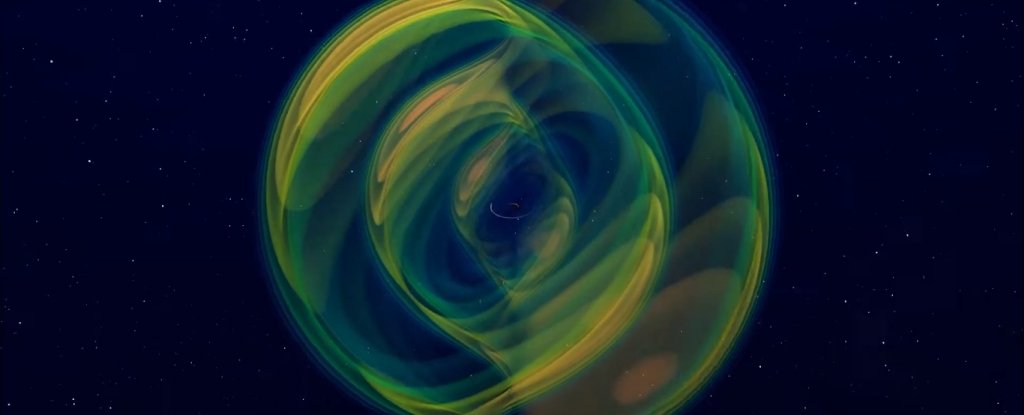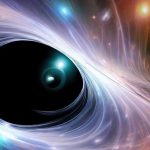Key takeaways
- The LIGO-Virgo collaboration detected gravitational waves from a unique black hole collision, GW 190412, involving an unequal mass binary.
- One black hole was about 29.7 times the mass of the Sun, while the other was just 8.4 solar masses, the lowest-mass pair yet discovered.
- The collision produced a longer and more detailed gravitational wave signal, revealing new insights into black hole formation and behavior.
- The gravitational waves from GW 190412 had two different frequencies, corresponding to a perfect fifth, akin to the first two notes of “Twinkle, Twinkle, Little Star.
- The team measured the spin of the larger black hole, indicating it may have previously merged with other black holes, suggesting a complex formation history.

The epic collision of two black holes, some 2.4 billion light-years distant, resulted in the discovery of gravitational waves by the LIGO-Virgo collaboration on April 12, 2019, a little over a year ago. Fortunately, this is by now nothing unusual in and of itself.
However, as astronomers have since disclosed, there was something unprecedented about the actual GW 190412 collision. GW 190412 was created by a radically unequal binary, not by two nearly equal-mass black holes between 20 and 40 times the mass of the Sun.
Astronomers have determined that one of the black holes tipped the scales at around 29.7 sun masses, while the other was more than three times smaller, at just 8.4 solar masses, based on study of the rippling gravitational waves.
Intriguingly, this is the lowest-mass black hole pair yet found, which implies that its union created a longer signal than any previous black hole merger, providing a plethora of information to explore.
“By itself, neither of these masses is very unexpected. Black holes are known to exist in these sizes. In a blog post, astronomer Christopher Berry of Northwestern University and the LIGO Collaboration stated, “What is new is the ratio of the masses.”
“This observation lets us test our predictions for gravitational wave signals in a new way, and is another piece in the puzzle of understanding how binary black holes form.”
The results of the Collaboration were presented at the American Physical Society’s Virtual April Meeting.
The signal reflects the fact that previous gravitational wave occurrences have been produced by black hole binaries of about identical mass. With every orbit, the black holes return to the same relative position since they have the same mass.
As a result, the gravitational wave frequency produced is around double that of the binary system’s orbital frequency, or the time it takes for the black holes to circle one another. However, the orbit is irregular when there is a considerable mass imbalance in the system. A second, weaker gravitational wave frequency is produced as a result.
A dyad of frequencies, akin to two guitar strings vibrating concurrently, was discovered in GW 190412, which created two different frequencies amid the family of chirps typically found in a black hole merger.
Surprisingly, these frequencies corresponded to a perfect fifth, or five notes apart. This musical interval is comprised of the first two twinkles in the song Twinkle, Twinkle, Little Star.
These frequencies were not only incredibly amazing, but they also made it possible for the researchers to conduct another general relativity test. In essence, scientists divided the gravitational wave signal into an earlier and a later half, and then they computed the other half of the signal for each half using general relativity-based equations.
The halves agreed with the computations, yielding some of the test’s most reliable findings to date.
Additionally, the team was able to obtain a few more measurements based on the odd signal from the merger. They were able to measure the bigger black hole’s spin, which is typically exceedingly difficult to do and has only been done (and hesitantly) in two prior mergers.
This spin appeared to be fairly quick in GW 190412, which may provide an indication as to how such an uneven binary formed. You see, there are a number of astrophysical theories that explain how black hole binaries originate, but the majority of them produce pairings that are roughly equal in mass.
A binary star system, when each star falls into a black hole, is the most apparent example. GW 190412 is assumed to be excluded since these are unable to form binary black holes with significant mass disparities.
It’s conceivable that the black holes created apart and later, by some mysterious process, merged and orbited each other. However, the bigger black hole’s strong spin implies that it could have amalgamated with other black holes earlier, prior to GW 190412.
It’s possible that the bigger black hole has already joined with the other black holes in a triple or quadruple system. The system would be disrupted if they were simply floating around in normal space, but there is one situation in which it may be effective: in the disc surrounding an active supermassive black hole in the center of a galaxy.
Because of the intense gravitational field there, stellar-mass black holes may be able to undergo several mergers without being ejected by the recoil kick.
Although it’s hard to say for sure right now, we might not have to wait too long to find out because the LIGO-Virgo cooperation is producing detections every few days.
By the way, GW 190412 caused more coincidences than just the dyad. “Approximately equal to the ratio of filling in a regular Oreo to in a Mega Stuf Oreo,” is how Berry described the mass ratio between the two black holes.
“Investigations of connections between Oreos and black hole formation are ongoing.”
The team’s whole article is available on the LIGO website.


